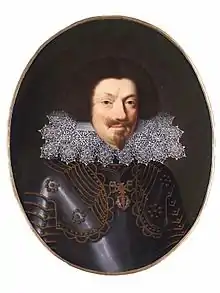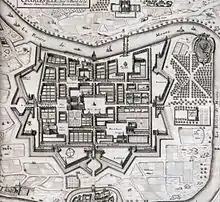Charles I Gonzaga, Duke of Mantua
Charles Gonzaga (Italian: Carlo I Gonzaga) (6 May 1580 – 22 September 1637) was Duke of Mantua and Duke of Montferrat from 1627 until his death. He was also Charles III Duke of Nevers and Rethel, as well as Prince of Arche and Charleville.
| Charles | |||||
|---|---|---|---|---|---|
 Engraving of Charles Gonzaga | |||||
| Duke of Mantua and Montferrat | |||||
| Reign | 1627–1637 | ||||
| Predecessor | Vincenzo II Gonzaga | ||||
| Successor | Charles II Gonzaga | ||||
| Born | 6 May 1580 Paris, France | ||||
| Died | 22 September 1637 (aged 57) Mantua | ||||
| Spouse | Catherine de Lorraine-Guise-Mayenne | ||||
| Issue Detail | Francis, Duke of Rethel Charles, Duke of Nevers Ferdinand, Duke of Mayenne Marie Louise, Queen of Poland Anna, Countess Palatine of Simmern | ||||
| |||||
| House | House of Gonzaga | ||||
| Father | Louis Gonzaga, Duke of Nevers | ||||
| Mother | Henriette of Cleves | ||||
Biography

Born in Paris, he was the son of Louis Gonzaga, Duke of Nevers and Princess Henriette of Cleves.[1]
In 1600, as duke of Rethel, he founded, in Nevers, the Order of the Yellow Ribbon, soon forbidden by the King, due to its peculiar character.
In 1606, he decided the foundation of Charleville[2] and the Principality of Arches ( fr ) He became 1st Prince of Arche and Charleville
In 1612, Charles, a descendant of the Byzantine Emperor Andronicus II Palaeologus through his grandmother Margaret, who was of the line of Theodore I, Marquess of Montferrat, Andronicus' son, claimed the throne of Constantinople, at the time the capital of the Ottoman Empire. He began plotting with Greek rebels, including the Maniots of Greece, who addressed him as "King Constantine Palaeologus". When the Ottoman authorities heard about this, they sent an army of 20,000 men and 70 ships to invade Mani. They succeeded in ravaging Mani and imposing taxes on the Maniots. This caused Charles to move more actively for his crusade. He sent envoys to the courts of Europe looking for support. In 1619, he recruited six ships and some five thousand men, but he was forced to abort the mission because of the beginning of the Thirty Years' War.[3]
At the death of the last legitimate male heir of the Gonzaga line in the Duchy of Mantua, Vincenzo II (1627), Charles inherited the title through an agreement. His son was married with Maria Gonzaga, daughter of former Duke Francesco IV.
However, his succession spurred the enmity of Charles Emmanuel I of Savoy, who aimed at the Gonzaga lands of Montferrat, and, above all, of Spain and the Holy Roman Empire, which did not like a philo-French ruler in Mantua. This led to the War of the Mantuan Succession. In 1629 emperor Ferdinand II sent a Landsknecht army to besiege Mantua, Charles left without the promised support from Louis XIII of France. The siege lasted until July 1630, when the city, already struck by a plague, was brutally sacked. Mantua never recovered from this disaster.
The subsequent diplomatic maneuvers allowed Charles, who had fled to the Papal States, to return to the duchy in 1631, although not without concessions to the House of Savoy and to the Gonzaga of Guastalla. The situation of the Mantuan lands was dramatic, but he was able to trigger some economic recovery in the following years.
Charles died in 1637. His successor was his grandson Charles II, initially under the regency of Maria Gonzaga, Charles I's daughter-in-law.
Children
Charles married Catherine of Lorraine-Mayenne,[4] daughter of Charles of Lorraine, Duke of Mayenne[5] and Princess Henriette of Savoy. They had six children:
- Francis Gonzaga, Duke of Rethel (1606–1622).
- Charles Gonzaga, Duke of Nevers, nominal co-ruler Duke of Mantua (1609 - 14 August 1631) and his heir. Better known as Duke of Nevers and Rethel. Married heiress Maria Gonzaga. They were parents to Eleanor of Mantua consort of the Holy Roman Emperor Ferdinand III, and Charles II, Duke of Mantua and Monferrat.
- Ferdinand Gonzaga, Duke of Mayenne (1610 - 25 May 1632).
- Marie Louise Gonzaga (18 August 1611 - 10 May 1667). Married first Władysław IV Vasa and secondly John II Casimir of Poland.
- Benedetta Gonzaga (1614 - 30 September 1637).
- Anne Marie Gonzaga (1616 - 6 July 1684).[6] Married first Henry II, Duke of Guise and secondly Edward, Count Palatine of Simmern.[5]
Ancestry
References
- Boltanski 2006, p. 501.
- , 'Encyclopædia Britannica, 9th ed., Vol. V, New York: Charles Scribner's Sons, 1878, p. 429.
- Greenhalgh and Eliopoulos, Deep into Mani: Journey into the Southern Tip of Greece", 26
- Parrott 1997, p. 157.
- Williams 1998, p. 66.
- Spangler 2015, p. 144.
Sources
- Boltanski, Ariane (2006). Les ducs de Nevers et l'État royal: genèse d'un compromis (ca 1550 - ca 1600) (in French). Librairie Droz.CS1 maint: ref=harv (link)
- Coniglio, Giuseppe (1967). I Gonzaga. Varese: Dall'Oglio.
- Parrott, David (1997). "A "prince souvereign" and the French crown: Charles de Nevers, 1580-1637". In Oresko, Robert; Gibbs, G. C.; Scott, H M (eds.). Royal and Republican Sovereignty in Early Modern Europe: Essays in Memory of Ragnhild Marie Hatton. Cambridge University Press. p. 149-187.CS1 maint: ref=harv (link)
- Spangler, Jonathan (2015). "Points of Transferral: Mademoiselle de Guise's Will and the Transferability of Dynastic Identity". In Geevers, Liesbeth; Marini, Mirella (eds.). Dynastic Identity in Early Modern Europe: Rulers, Aristocrats and the Formation of Identities. Ashgate Publishing. p. 131-152.CS1 maint: ref=harv (link)
- Williams, George L. (1998). Papal Genealogy: The Families and Descendants of the Popes. McFarland & Company, Inc.CS1 maint: ref=harv (link)
| Preceded by Vincenzo II |
Duke of Mantua and Montferrat 1627–1637 |
Succeeded by Charles II & III |
| Preceded by Henriette |
Duke of Nevers and Rethel 1595–1637 |
External links
- Marek, Miroslav. "A listing of descendants of Francesco II Gonzaga, Marquess of Mantua". Genealogy.EU.